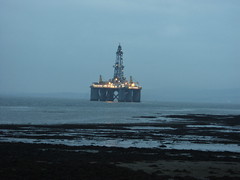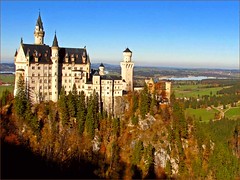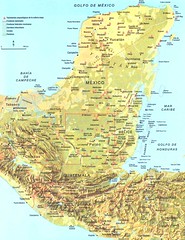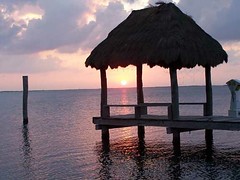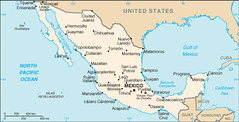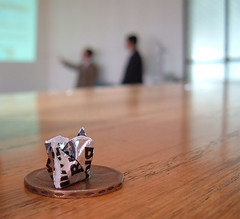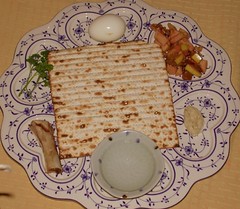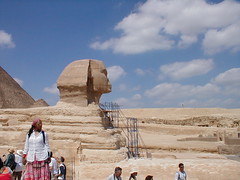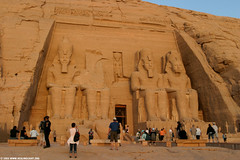Wed, May 17 deadline:
Digital portfolio updated to 12 images:
5 from fall semester and 7 from spring semester.
20 pts. (3 pts. per image)
Requirements:
* Photos of you and your work (10), events you attended (2).
* Brief commentary, such as name, date, subject, type-of or name-of project or location, names of elements or other people in photo.
* Store on:
- web site
- flash drive
- compact disk (sorry, no 3.5" diskettes allowed).
Saturday, April 29, 2006
Oil Rig Platform, Scottish coast: a brief history of oil from Wikipedia
The first oil wells were drilled in China in the 4th century or earlier. They had depth of up to 243 meters and were drilled using bits attached to bamboo poles. The oil was burned to evaporate brine and produce salt. By the 10th century, extensive bamboo pipelines connected oil wells with salt springs.
Ancient Persian tablets indicate the medicinal and lighting uses of petroleum in the upper echelons of their society.
In the 8th century, the streets of the newly-constructed Baghdad were paved with tar, derived from easily-accessible petroleum from natural fields in the region. In the 9th century, oil fields were exploited in Baku, Azerbaijan, to produce naphtha. These fields were described by the geographer Masudi in the 10th century, and by Marco Polo in the 13th century, who described the output of those wells as hundreds of shiploads. (See also: Timeline of Islamic science and technology.)
The modern history of petroleum began in 1846, with the discovery of the process of refining kerosene from coal by Atlantic Canada's Abraham Pineo Gesner. Poland's Ignacy Łukasiewicz discovered a means of refining kerosene from the more readily available "rock oil" ("petr-oleum") in 1852 and the first rock oil mine was built in Bobrka, near Krosno in southern Poland in the following year.
These discoveries rapidly spread around the world, and Meerzoeff built the first Russian refinery in the mature oil fields at Baku in 1861. At that time Baku produced about 90% of the world's oil. The battle of Stalingrad was fought over Baku (now the capital of the Azerbaijan Republic).
Oil field in California, 1938. The first modern oil well was drilled in 1848 by Russian engineer F.N. Semyonov, on the Aspheron Peninsula north-east of Baku.
The first commercial oil well drilled in North America was in Oil Springs, Ontario, Canada in 1858, dug by James Miller Williams.
The American petroleum industry began with Edwin Drake's discovery of oil in 1859, near Titusville, Pennsylvania. The industry grew slowly in the 1800s, driven by the demand for kerosene and oil lamps. It became a major national concern in the early part of the 20th century; the introduction of the internal combustion engine provided a demand that has largely sustained the industry to this day.
Early "local" finds like those in Pennsylvania and Ontario were quickly exhausted, leading to "oil booms" in Texas, Oklahoma, and California.
By 1910, significant oil fields had been discovered in Canada (specifically, in the province of Alberta), the Dutch East Indies (1885, in Sumatra), Persia (1908, in Masjed Soleiman), Peru, Venezuela, and Mexico, and were being developed at an industrial level.
Until the mid-1950s, coal was still the world's foremost fuel, but oil quickly took over. Following the 1973 energy crisis and the 1979 energy crisis, there was significant media coverage of oil supply levels. This brought to light the concern that oil is a limited resource that will eventually run out, at least as an economically viable energy source. At the time, the most common and popular predictions were always quite dire, and when they did not come true, many dismissed all such discussion.
The future of petroleum as a fuel remains somewhat controversial. USA Today news (2004) reports that there are 40 years of petroleum left in the ground. Some would argue that because the total amount of petroleum is finite, the dire predictions of the 1970s have merely been postponed. Others argue that technology will continue to allow for the production of cheap hydrocarbons and that the earth has vast sources of unconventional petroleum reserves in the form of tar sands, bitumen fields and oil shale that will allow for petroleum use to continue in the future, with both the Canadian tar sands and United States shale oil deposits representing potential reserves matching existing liquid petroleum deposits worldwide.
Today, about 90% of vehicular fuel needs are met by oil. Petroleum also makes up 40% of total energy consumption in the United States, but is responsible for only 2% of electricity generation. Petroleum's worth as a portable, dense energy source powering the vast majority of vehicles and as the base of many industrial chemicals makes it one of the world's most important commodities.
Access to oil was a major factor in several military conflicts, including World War II and the Persian Gulf War. About 80% of the world's readily accessible reserves are located in the Middle East, with 62.5% coming from the Arab 5: Saudi Arabia (12.5%), UAE, Iraq, Qatar and Kuwait.
The USA has less than 3%.
Ancient Persian tablets indicate the medicinal and lighting uses of petroleum in the upper echelons of their society.
In the 8th century, the streets of the newly-constructed Baghdad were paved with tar, derived from easily-accessible petroleum from natural fields in the region. In the 9th century, oil fields were exploited in Baku, Azerbaijan, to produce naphtha. These fields were described by the geographer Masudi in the 10th century, and by Marco Polo in the 13th century, who described the output of those wells as hundreds of shiploads. (See also: Timeline of Islamic science and technology.)
The modern history of petroleum began in 1846, with the discovery of the process of refining kerosene from coal by Atlantic Canada's Abraham Pineo Gesner. Poland's Ignacy Łukasiewicz discovered a means of refining kerosene from the more readily available "rock oil" ("petr-oleum") in 1852 and the first rock oil mine was built in Bobrka, near Krosno in southern Poland in the following year.
These discoveries rapidly spread around the world, and Meerzoeff built the first Russian refinery in the mature oil fields at Baku in 1861. At that time Baku produced about 90% of the world's oil. The battle of Stalingrad was fought over Baku (now the capital of the Azerbaijan Republic).
Oil field in California, 1938. The first modern oil well was drilled in 1848 by Russian engineer F.N. Semyonov, on the Aspheron Peninsula north-east of Baku.
The first commercial oil well drilled in North America was in Oil Springs, Ontario, Canada in 1858, dug by James Miller Williams.
The American petroleum industry began with Edwin Drake's discovery of oil in 1859, near Titusville, Pennsylvania. The industry grew slowly in the 1800s, driven by the demand for kerosene and oil lamps. It became a major national concern in the early part of the 20th century; the introduction of the internal combustion engine provided a demand that has largely sustained the industry to this day.
Early "local" finds like those in Pennsylvania and Ontario were quickly exhausted, leading to "oil booms" in Texas, Oklahoma, and California.
By 1910, significant oil fields had been discovered in Canada (specifically, in the province of Alberta), the Dutch East Indies (1885, in Sumatra), Persia (1908, in Masjed Soleiman), Peru, Venezuela, and Mexico, and were being developed at an industrial level.
Until the mid-1950s, coal was still the world's foremost fuel, but oil quickly took over. Following the 1973 energy crisis and the 1979 energy crisis, there was significant media coverage of oil supply levels. This brought to light the concern that oil is a limited resource that will eventually run out, at least as an economically viable energy source. At the time, the most common and popular predictions were always quite dire, and when they did not come true, many dismissed all such discussion.
The future of petroleum as a fuel remains somewhat controversial. USA Today news (2004) reports that there are 40 years of petroleum left in the ground. Some would argue that because the total amount of petroleum is finite, the dire predictions of the 1970s have merely been postponed. Others argue that technology will continue to allow for the production of cheap hydrocarbons and that the earth has vast sources of unconventional petroleum reserves in the form of tar sands, bitumen fields and oil shale that will allow for petroleum use to continue in the future, with both the Canadian tar sands and United States shale oil deposits representing potential reserves matching existing liquid petroleum deposits worldwide.
Today, about 90% of vehicular fuel needs are met by oil. Petroleum also makes up 40% of total energy consumption in the United States, but is responsible for only 2% of electricity generation. Petroleum's worth as a portable, dense energy source powering the vast majority of vehicles and as the base of many industrial chemicals makes it one of the world's most important commodities.
Access to oil was a major factor in several military conflicts, including World War II and the Persian Gulf War. About 80% of the world's readily accessible reserves are located in the Middle East, with 62.5% coming from the Arab 5: Saudi Arabia (12.5%), UAE, Iraq, Qatar and Kuwait.
The USA has less than 3%.
Neuschwanstein Castle: Deutschsland
Deutschland and the Deutsch
Martin Luther
Johannes Gutenberg
Johann Sebastian Bach
Ludwig van Beethoven
Albert Einstein
Albrecht Durer
Nikolaus Otto
Count Von Zeppelin
Josef Leitz
Karl Marx
Ferdinand Porsche
Adi Dassler
Audi
Mercedes Benz (Daimler Chrysler)
Bavarian Motor Works (BMW)
Volkswagen
Porsche
BASF
Bayer Aspirin (acetylsalicylic acid)
Addidas, Puma
Leica
German immigrants:
hamburger
frankfurter
apple pie
cherry pie
pretzels
Great Depression / 1930's >
appeal of communism >
Fascists offer opposition to communists, win support ofnthe wealthy class >
1933: Hitler wins election >
Hitler manipulates Deutsch politics >
1939 - 1945, war >
Luftwaffe
Messerschmitt
V-1, V-2 guided missles
Battle of Britain
Other vovab:
arboreal
palina
Martin Luther
Johannes Gutenberg
Johann Sebastian Bach
Ludwig van Beethoven
Albert Einstein
Albrecht Durer
Nikolaus Otto
Count Von Zeppelin
Josef Leitz
Karl Marx
Ferdinand Porsche
Adi Dassler
Audi
Mercedes Benz (Daimler Chrysler)
Bavarian Motor Works (BMW)
Volkswagen
Porsche
BASF
Bayer Aspirin (acetylsalicylic acid)
Addidas, Puma
Leica
German immigrants:
hamburger
frankfurter
apple pie
cherry pie
pretzels
Great Depression / 1930's >
appeal of communism >
Fascists offer opposition to communists, win support ofnthe wealthy class >
1933: Hitler wins election >
Hitler manipulates Deutsch politics >
1939 - 1945, war >
Luftwaffe
Messerschmitt
V-1, V-2 guided missles
Battle of Britain
Other vovab:
arboreal
palina
Wednesday, April 26, 2006
A visit to Maya country via Spanish teacher Pablo Flowers
When CMHS teacher Paul Flowers went to the Mexican state of Tabasco at spring break, he took his camera and brought back images of country life and Mayan history.
Here's some of what I learned when we combined classes:
* hermanos: "brothers"
* iglesias: "church"
* in rural Mexico, physicians do not earn the princely salaries collected by US docs.
* a taco is simply a soft tortilla plus spicy meat.
* the Mayan ruins of Palenque include pyramids, ball court, residences, astronomical observatory and a great deal of relief sculpture.
* Protestant churches are important to the Mexican people today; once all of Mexico was Roman Catholic.
* rural Mexicans slaughter cattle on site for a big gathering. they consume *every bit* of the carcass.
* the giant mango tree and many other fruit trees are common in the tropical region.
* ranch hands make perhaps $5 per day, but they work only about 4 hours and their cost of living - for basics - is low.
* cacao is one of the rich products of the jungle of southern Mexico.
Examine the map of Maya territory. Which of today's countries lies upon their lands?
Here's some of what I learned when we combined classes:
* hermanos: "brothers"
* iglesias: "church"
* in rural Mexico, physicians do not earn the princely salaries collected by US docs.
* a taco is simply a soft tortilla plus spicy meat.
* the Mayan ruins of Palenque include pyramids, ball court, residences, astronomical observatory and a great deal of relief sculpture.
* Protestant churches are important to the Mexican people today; once all of Mexico was Roman Catholic.
* rural Mexicans slaughter cattle on site for a big gathering. they consume *every bit* of the carcass.
* the giant mango tree and many other fruit trees are common in the tropical region.
* ranch hands make perhaps $5 per day, but they work only about 4 hours and their cost of living - for basics - is low.
* cacao is one of the rich products of the jungle of southern Mexico.
Examine the map of Maya territory. Which of today's countries lies upon their lands?
Tuesday, April 25, 2006
Cancun sunset: exploring the map of Mexico
Map review:
1) 2 Mexican peninsulas:
2) 3 bodies of water bordering Mex.
3) Volcanic mountain peak east of Mex City.
4) Pacific resort.
5) Two southern neighbors.
6) 2nd most populous city.
7) Island.
8) 4 states.
9) Mountain range.
10) T / F There are over a hundred WalMarts in Mexico.
1. Baja, Yucatan.
2. Gulf of Mex, Pacific, Caribbean.
3. Popocatepetl
4. Acapulco, cabo san Lucas.
5. Guatemala, Belize.
6. Guadalajara
7. Cozumel, Cancun, Mujeres.
8. AZ, CA, NM, TX
9. Sierra madre Oriental, also SM Occidental and SM del Sur.
10. True, acc to Walmart.com.
Vocab:
palapa (see illustration)
batidos
horchata
hola
1) 2 Mexican peninsulas:
2) 3 bodies of water bordering Mex.
3) Volcanic mountain peak east of Mex City.
4) Pacific resort.
5) Two southern neighbors.
6) 2nd most populous city.
7) Island.
8) 4 states.
9) Mountain range.
10) T / F There are over a hundred WalMarts in Mexico.
1. Baja, Yucatan.
2. Gulf of Mex, Pacific, Caribbean.
3. Popocatepetl
4. Acapulco, cabo san Lucas.
5. Guatemala, Belize.
6. Guadalajara
7. Cozumel, Cancun, Mujeres.
8. AZ, CA, NM, TX
9. Sierra madre Oriental, also SM Occidental and SM del Sur.
10. True, acc to Walmart.com.
Vocab:
palapa (see illustration)
batidos
horchata
hola
Monday, April 24, 2006
Bocce: a bit of Europe on the CMHS campus
Play a bit of Bocce on the quad at mag this week during geo class!
Qualify by bringing in a print-out of research on
a) the history and
b) the rules (general) of the game.
Be sure to highlight the history to show me you've read the material.
5 pts. bonus credit. This week only.
Qualify by bringing in a print-out of research on
a) the history and
b) the rules (general) of the game.
Be sure to highlight the history to show me you've read the material.
5 pts. bonus credit. This week only.
Wed presentation on Tabasco, Mexico, by Spanish teacher Mr Paul Flowers
Thursday's map quiz comprises . . .
Cal, Ariz, NM, Tx
Laredo, El Paso, San Diego, Corpus Christi
Ciudad Juarez, Nuevo Laredo, Tijuana
Rio Grande, Pacific, Gulf of Mexico, Caribbean
Guadalajara, Mex City, Acapulco, Cancun
Mt. Popocatepetl (volcano)
Yucatan peninsula, Tabasco state, Isla Cozumel
Guatemala, Belize (English-speaking)
Cal, Ariz, NM, Tx
Laredo, El Paso, San Diego, Corpus Christi
Ciudad Juarez, Nuevo Laredo, Tijuana
Rio Grande, Pacific, Gulf of Mexico, Caribbean
Guadalajara, Mex City, Acapulco, Cancun
Mt. Popocatepetl (volcano)
Yucatan peninsula, Tabasco state, Isla Cozumel
Guatemala, Belize (English-speaking)
Thursday, April 20, 2006
It's 500 BC; you have left your home in Greece and arrived in Egypt
Imagine a Mediterranean journey . . .
This week's essay asks you to comb your notes for details that will bring to life a journey from Greece to Egypt in 500 BC. That date represents the high point of Athenian civilization, yet in Egypt the glorious reign of the Pharaohs has ended. Describe a sea voyage from Athens to Alexandria and a trek down the Nile to Thebes. Describe yourself (aristocrat? slave?) and your companions. Include dialogue. Your points will come from descriptions of architecture, landscape and cultural elements. Use your notes! BTW, in 500 BC Egypt has been conquered by the Persians and the Pharaonic era has been over for some time. 10 pts (or up to 15 for outstanding inclusion of abundant detail).
This week's essay asks you to comb your notes for details that will bring to life a journey from Greece to Egypt in 500 BC. That date represents the high point of Athenian civilization, yet in Egypt the glorious reign of the Pharaohs has ended. Describe a sea voyage from Athens to Alexandria and a trek down the Nile to Thebes. Describe yourself (aristocrat? slave?) and your companions. Include dialogue. Your points will come from descriptions of architecture, landscape and cultural elements. Use your notes! BTW, in 500 BC Egypt has been conquered by the Persians and the Pharaonic era has been over for some time. 10 pts (or up to 15 for outstanding inclusion of abundant detail).
Wednesday, April 19, 2006
Mummy of Antjau
Egyptian pharaoh comparison reports due Mon, Ap 24.
1) Choose either essay or powerpoint-type presentation.
2) Pp:
* each slide must address both topics
* keep each slide simple: 2 to 3 bulleted items.
* have script from which to read.
* include a source on each image.
* have a photo-type image in each slide.
* include a map.
3) Wikipedia.org must be balanced by use of worldbookonline.com, infoplease.com, cia.gov, britannica, etc. Please use 2 traditional sources in addition to wikipedia.
4) Snappy title, explanatory subtitle, grammar, spelling.
5) Please don';t use a diskette. Lately 9 out of 10 of them don't work in C4's computers. Please use a flash drive or Yousendit.com.
Basic comparison personages:
Tutankhamen, Ramses II, Akhenaton, Hatshepsut and the non-pharaonic era person, Cleopatra VII.
To whom can you compare them?
Any political leader from another era and another nation. Ex: Montezuma, Louis XIV, etc.
1) Choose either essay or powerpoint-type presentation.
2) Pp:
* each slide must address both topics
* keep each slide simple: 2 to 3 bulleted items.
* have script from which to read.
* include a source on each image.
* have a photo-type image in each slide.
* include a map.
3) Wikipedia.org must be balanced by use of worldbookonline.com, infoplease.com, cia.gov, britannica, etc. Please use 2 traditional sources in addition to wikipedia.
4) Snappy title, explanatory subtitle, grammar, spelling.
5) Please don';t use a diskette. Lately 9 out of 10 of them don't work in C4's computers. Please use a flash drive or Yousendit.com.
Basic comparison personages:
Tutankhamen, Ramses II, Akhenaton, Hatshepsut and the non-pharaonic era person, Cleopatra VII.
To whom can you compare them?
Any political leader from another era and another nation. Ex: Montezuma, Louis XIV, etc.
Tuesday, April 18, 2006
A student's collection of presentation guidelines
Jered Batten, 6th hr geo, collected this material on presentations and sent it to me as an offering for the class web site. Thanks, Jered!
3 Components of an Effective Presentation
An effective presentation must get three components right:
• Content
• Design
• Delivery
Each of these components has to be on the mark and they all have to work together, as well.
When writing your content, decide on two or three main points and make sure that everything else that you write leads to those points. Make your content logical, simple, and clear. Figure out what your audience needs and wants to know and tailor your content for the audience.
Regarding design, your number one concern is legibility. Don’t put too much text on a slide and keep it large enough to read easily. The text color should contrast highly with the background color. Then, make sure that your design complements your content. Your background and images shouldn’t detract from the content. Images should work to clarify text. The layout and size of text should bring important points to the fore.
Don’t forget a winning delivery. Engaging your audience with eye contact and your overall energy is important. Know your main points and emphasize them with your voice and the amount of time you spend on them. Two’s a party; three’s a crowd, they say. If you just read your slides, you’re putting PowerPoint between you and the audience and they’ll resent it. Instead, use the slides only as support for your presentation.
Additional materials:
Nevertheless, if you're looking to create a smart, fast presentation, you might use this technique. Here are some more tips:
1. Let the text on the slide repeat a word or phrase that you're using, no more.
2. Use images that evoke what you're saying, but don't add any words to the images.
3. Show each slide for just a second or two. This method uses lots of slides, each for a short time.
4. Keep the pace fast.
Expanding One Slide into Two
If you can't make text fit properly on one slide without squeezing it in too tightly, split the text into two slides. If the text is in a text placeholder, this is easily done using the Outline toolbar. To display the OUtline toolbar, right-click any toolbar and choose Outline.
Jered found quite a few more techniques that were appropriate for advanced presenters. See him or pursue your own web search to advance your skills.
3 Components of an Effective Presentation
An effective presentation must get three components right:
• Content
• Design
• Delivery
Each of these components has to be on the mark and they all have to work together, as well.
When writing your content, decide on two or three main points and make sure that everything else that you write leads to those points. Make your content logical, simple, and clear. Figure out what your audience needs and wants to know and tailor your content for the audience.
Regarding design, your number one concern is legibility. Don’t put too much text on a slide and keep it large enough to read easily. The text color should contrast highly with the background color. Then, make sure that your design complements your content. Your background and images shouldn’t detract from the content. Images should work to clarify text. The layout and size of text should bring important points to the fore.
Don’t forget a winning delivery. Engaging your audience with eye contact and your overall energy is important. Know your main points and emphasize them with your voice and the amount of time you spend on them. Two’s a party; three’s a crowd, they say. If you just read your slides, you’re putting PowerPoint between you and the audience and they’ll resent it. Instead, use the slides only as support for your presentation.
Additional materials:
Nevertheless, if you're looking to create a smart, fast presentation, you might use this technique. Here are some more tips:
1. Let the text on the slide repeat a word or phrase that you're using, no more.
2. Use images that evoke what you're saying, but don't add any words to the images.
3. Show each slide for just a second or two. This method uses lots of slides, each for a short time.
4. Keep the pace fast.
Expanding One Slide into Two
If you can't make text fit properly on one slide without squeezing it in too tightly, split the text into two slides. If the text is in a text placeholder, this is easily done using the Outline toolbar. To display the OUtline toolbar, right-click any toolbar and choose Outline.
Jered found quite a few more techniques that were appropriate for advanced presenters. See him or pursue your own web search to advance your skills.
The lotus columns of Luxor's Temple of Amun Ra
Wed. Library research so as to create a comparison between a pharaoh aqnd other political leader from another nation, another era.
Thurs: Map quiz, Egypt. Hand-sketched.
Fri. Begin presentations on Comparisons based on pharaohs. Can be either an essay or 6-slide powerpoint.
Map review:
1. Egyptian peninsula.
2. Ancient capital of Lower Egypt.
3. Ancient capital of Upper Egypt.
4. The delta.
5. Old Kingdom monuments.
6. Valley of the Kings.
7. Cleopatra's capital.
8. Monument near border with Sudan.
9. Nation that is the source of the Blue Nile.
10. Body of water that is the source of the White Nile.
Bonus credit for writing about the
Spring Dance being sponsored by the Class of 09.
* 5 to 8 pm on Fri, Ap 21.
* tickets must be purchased in advance, $3.
* we need chaperones; all p[arents are welcome, even if you can only stay one hour.
* pizza and coke on sale after school for those staying for the dance.
Don't forget building the images in your digital portfolio. At semester's end you must have 7 images from this semester, half representing school activities.
Thurs: Map quiz, Egypt. Hand-sketched.
Fri. Begin presentations on Comparisons based on pharaohs. Can be either an essay or 6-slide powerpoint.
Map review:
1. Egyptian peninsula.
2. Ancient capital of Lower Egypt.
3. Ancient capital of Upper Egypt.
4. The delta.
5. Old Kingdom monuments.
6. Valley of the Kings.
7. Cleopatra's capital.
8. Monument near border with Sudan.
9. Nation that is the source of the Blue Nile.
10. Body of water that is the source of the White Nile.
Bonus credit for writing about the
Spring Dance being sponsored by the Class of 09.
* 5 to 8 pm on Fri, Ap 21.
* tickets must be purchased in advance, $3.
* we need chaperones; all p[arents are welcome, even if you can only stay one hour.
* pizza and coke on sale after school for those staying for the dance.
Don't forget building the images in your digital portfolio. At semester's end you must have 7 images from this semester, half representing school activities.
Wednesday, April 12, 2006
Murderous mobster arrested near Corleone, Sicily / NYTimes
April 12, 2006
Police Seize Top Mafioso After 43 Years
By ELISABETTA POVOLEDO
ROME, April 11 — Tipped off by a mundane delivery of laundry, the Italian police arrested Bernardo Provenzano, boss of all bosses of the Sicilian Mafia, on Tuesday. He had been on the run for 43 years, and the news was so big that it overtook coverage of the photo-finish Italian elections.
The police caught up with Mr. Provenzano, 73, in a farmhouse not far from Corleone, the hilltop Sicilian town made famous by Mario Puzo's "Godfather" novels.
In real life, Corleone spawned a vicious Mafia family, currently led by Mr. Provenzano, that dominated organized crime on the island for decades, leaving a trail of blood in murdered prosecutors, reporters and investigators. He has already been sentenced in absentia to life in prison at least six times as a member of the so-called Mafia Cupola, responsible for coordinating mob strategy.
The police had been monitoring Mr. Provenzano's wife and two sons, who returned to Sicily in 1993 when he became head of the Corleone family. On Tuesday investigators spotted a bundle of laundry being sent from her house to a remote farmhouse. As investigators explained it, they saw a hand come out from a door to take the package, and they decided to act.
Mr. Provenzano did not put up a struggle when the police special forces burst into the farmhouse. "He didn't say a word," the Palermo police commissioner, Giuseppe Caruso, told reporters at a packed news conference in Rome.
When Mr. Provenzano arrived at a Palermo police station, bystanders called out insults. Television newscasts showed an unruly crowd yelling "Assassin!" and "Bastard!" at Mr. Provenzano, a diminutive, silver-haired senior citizen dwarfed by the black-hooded police officers jostling him through.
Officials involved in the arrest said the preparations had begun several years ago. Working from one of the few known photographs of Mr. Provenzano — a 1959 snapshot — the police artificially aged the image on a computer, and picked up his trail when he underwent surgery in a clinic in Marseille, France, in 2003. Around a year ago, the circle began to "progressively close in around Provenzano and his accomplices," Giuseppe Pisanu, the interior minister, said at the news conference.
"The Mafia has lost its most prestigious leader," Mr. Pisanu said. "It has undergone an undeniable decapitation."
Mr. Caruso said cameras had been planted in fields surrounding Corleone, where, according to Pietro Grasso, Italy's top anti-Mafia prosecutor, the ailing mobster had come "to take refuge" near those "he most trusted."
Mr. Grasso said "an entire world" of professionals, business executives and politicians had aided Mr. Provenzano during his time on the run.
Mr. Provenzano's ability to outwit investigators for 43 years made him a lingering symbol for many Italians of the state's inability to eradicate the Mafia. And it raised suspicions that the elusive mobster had friends in high places.
Mafia turncoats arrested over the past decade confirmed to investigators that Mr. Provenzano was at the head of a criminal organization that controlled public works contracts and a sizable protection racket. Mr. Grasso said it was unlikely that the mobster would turn state's evidence, "though I hope I'm mistaken."
In a televised interview, Giancarlo Caselli, a prosecutor who once led Palermo's anti-Mafia team, warned that other important bosses had been captured in the past, "and this didn't mean the end of the Mafia."
See photos at http://www.nytimes.com/2006/04/12/world/europe/12mafia.html?ex=1144987200&en=739a11685510eafa&ei=5087%0A
This article is not part of geo testing, BTW.
Police Seize Top Mafioso After 43 Years
By ELISABETTA POVOLEDO
ROME, April 11 — Tipped off by a mundane delivery of laundry, the Italian police arrested Bernardo Provenzano, boss of all bosses of the Sicilian Mafia, on Tuesday. He had been on the run for 43 years, and the news was so big that it overtook coverage of the photo-finish Italian elections.
The police caught up with Mr. Provenzano, 73, in a farmhouse not far from Corleone, the hilltop Sicilian town made famous by Mario Puzo's "Godfather" novels.
In real life, Corleone spawned a vicious Mafia family, currently led by Mr. Provenzano, that dominated organized crime on the island for decades, leaving a trail of blood in murdered prosecutors, reporters and investigators. He has already been sentenced in absentia to life in prison at least six times as a member of the so-called Mafia Cupola, responsible for coordinating mob strategy.
The police had been monitoring Mr. Provenzano's wife and two sons, who returned to Sicily in 1993 when he became head of the Corleone family. On Tuesday investigators spotted a bundle of laundry being sent from her house to a remote farmhouse. As investigators explained it, they saw a hand come out from a door to take the package, and they decided to act.
Mr. Provenzano did not put up a struggle when the police special forces burst into the farmhouse. "He didn't say a word," the Palermo police commissioner, Giuseppe Caruso, told reporters at a packed news conference in Rome.
When Mr. Provenzano arrived at a Palermo police station, bystanders called out insults. Television newscasts showed an unruly crowd yelling "Assassin!" and "Bastard!" at Mr. Provenzano, a diminutive, silver-haired senior citizen dwarfed by the black-hooded police officers jostling him through.
Officials involved in the arrest said the preparations had begun several years ago. Working from one of the few known photographs of Mr. Provenzano — a 1959 snapshot — the police artificially aged the image on a computer, and picked up his trail when he underwent surgery in a clinic in Marseille, France, in 2003. Around a year ago, the circle began to "progressively close in around Provenzano and his accomplices," Giuseppe Pisanu, the interior minister, said at the news conference.
"The Mafia has lost its most prestigious leader," Mr. Pisanu said. "It has undergone an undeniable decapitation."
Mr. Caruso said cameras had been planted in fields surrounding Corleone, where, according to Pietro Grasso, Italy's top anti-Mafia prosecutor, the ailing mobster had come "to take refuge" near those "he most trusted."
Mr. Grasso said "an entire world" of professionals, business executives and politicians had aided Mr. Provenzano during his time on the run.
Mr. Provenzano's ability to outwit investigators for 43 years made him a lingering symbol for many Italians of the state's inability to eradicate the Mafia. And it raised suspicions that the elusive mobster had friends in high places.
Mafia turncoats arrested over the past decade confirmed to investigators that Mr. Provenzano was at the head of a criminal organization that controlled public works contracts and a sizable protection racket. Mr. Grasso said it was unlikely that the mobster would turn state's evidence, "though I hope I'm mistaken."
In a televised interview, Giancarlo Caselli, a prosecutor who once led Palermo's anti-Mafia team, warned that other important bosses had been captured in the past, "and this didn't mean the end of the Mafia."
See photos at http://www.nytimes.com/2006/04/12/world/europe/12mafia.html?ex=1144987200&en=739a11685510eafa&ei=5087%0A
This article is not part of geo testing, BTW.
Passover: ancient Jewish celebration / Seder Plate
Passover (Hebrew: פסח; transliterated as Pesach or Pesah), also called חג המצות (Chag HaMatzot - Festival of Matzot) is a Jewish holiday, says wikipedia, beginning on the 15th day of Nisan which commemorates the Exodus and freedom of the Israelites from ancient Egypt. Passover marks the "birth" of the Jewish nation, as the Jews were freed from being slaves of Pharaoh and allowed to become servants of God instead.
Together with Sukkot and Shavuot, Passover is one of the three pilgrim festivals (Shalosh Regalim) during which the entire Jewish populace made a pilgrimage to Jerusalem in the days of the Holy Temple.
In Israel, Passover is a 7-day holiday, with the first and last days celebrated as a full festival (involving abstention from work, special prayer services and holiday meals). Outside Israel, the holiday is celebrated for 8 days, with the first two days and last two days celebrated as full festivals. The intervening days are known as Chol HaMoed (festival weekdays).
The primary symbol of Passover is the matzo, a flat, unleavened bread which recalls the bread that the Israelites ate after their hasty departure from Egypt. According to Halakha, this bread is made from a dough of flour and water only, which has not been allowed to rise for more than 18-22 minutes. Religious Jews will observe the positive Torah commandment of eating matzo on the first night, as well as the Torah prohibition against eating or owning any leavened products — such as bread, cake, cookies, or pasta (anything whose dough has been mixed with a leavening agent or which has been left to rise more than 18-22 minutes) — for the duration of the holiday.
Together with Sukkot and Shavuot, Passover is one of the three pilgrim festivals (Shalosh Regalim) during which the entire Jewish populace made a pilgrimage to Jerusalem in the days of the Holy Temple.
In Israel, Passover is a 7-day holiday, with the first and last days celebrated as a full festival (involving abstention from work, special prayer services and holiday meals). Outside Israel, the holiday is celebrated for 8 days, with the first two days and last two days celebrated as full festivals. The intervening days are known as Chol HaMoed (festival weekdays).
The primary symbol of Passover is the matzo, a flat, unleavened bread which recalls the bread that the Israelites ate after their hasty departure from Egypt. According to Halakha, this bread is made from a dough of flour and water only, which has not been allowed to rise for more than 18-22 minutes. Religious Jews will observe the positive Torah commandment of eating matzo on the first night, as well as the Torah prohibition against eating or owning any leavened products — such as bread, cake, cookies, or pasta (anything whose dough has been mixed with a leavening agent or which has been left to rise more than 18-22 minutes) — for the duration of the holiday.
Egypt and the Pharaohs
Aegypticus / the Latin name for Egypt
Exploring Egypt, "Gift of the Nile," and Africa
geography / Trudeau
1. Who were the outsiders who trekked deeply into North and West Africa - about the year 1000 AD - to trade and leave behind their cultural influences?
a) Arabs b) Romans c) Greeks d) Hindus
The desert-wise Arabs!
2. These intrepid traders crossed the Sahara to trade with the peoples of West Africa. The motivation for such a trek was (choose 3):
a) slaves b) gold c) ivory d) fabrics e) masks f) music & dance.
Slaves, gold & ivory - today the world loves the fabrics, masks and music & dance of the African continent.
3. The Romans conquered the lands on the rim of North Africa about the time of Christ. They established trade with and built cities in 5 African-Mediterranean nations: __, __, __, __, & __. Please see your atals.
4. East Africa's trading neighbors would be the Arabs and others from the nations that lie closest to the border. These 4 nations would be __, __, __ & __. See yr atlas , please.
5. Which location offers evidence that the Arabs sailed down the east coast of Africa to establish trading centers? a) Mogadishu b) Mombasa c) Dar es Salaam.
Dar es salaam means the"haven of peace" in Arabic.
6. Did the Pharaonic era Egyptians have serious trouble from Midddle Eastern tribal nations? Yes / No.
Yes. In fact, peoples from Palestine/Lebanon, the Hyksos, took ruled Egypt for a time during the age of the Pharaohs.
7. The "look" of a modern Egyptian: does he look a bit like the ancient Pharaohs and a bit like a blend of the ethnic groups who've invaded Egypt over the centuries? Do Egyptians look like a "crossroads" people? Yes / No .
Yes. This is my opinion, but I spent 6 weeks studying Egypt and Egyptians on a Fulbright Fellowship, so ...
8. What is the area of Egypt? __ million sq. miles. Is it about the same as that of Nigeria? __ million sq. miles.
9. What is the population of Egypt? __ million The population of Nigeria? __ million
10. How do you explain the differences between the Egyptian and Nigerian statistics? _____________
Which came first, the Great Pyramids or the Valley of the Kings?
The pyramids came from the Old Kingdom, the Valley of the Kings from the Middle Kingdom.
* Egypt was part of the Roman Empire. Supplied wheat to Rome and the rest of the empire. Was a source of wild animals used in the coliseums' gladiatorial extravaganzas.
* The reading of hieroglyphic messages fell into disuse after the invasion of Alexander the Great (which preceded the Roman era). He brought the Greek language and culture to Egypt and the Middle East. With the extinction of the priest class and the old-style pharaohs, Hieroglyphics were replaced by Greek and Demotic script.
* Rosetta Stone: in 1799 Napoleon's soldiers dug up a basalt announcement stone with 3 scripts: Greek, Demotic and Hieroglyphics. Written about 200 BC, it was the key to translating the hieroglyphics. Credit for translation goes to Frenchman Jean Francois Chompollion.
Today the Rosetta Stone is in the British Museum, London.
* The white limestone blocks that clad the Great Pyramids in a smooth "skin" were also lost in antiquity. They were taken from the Pyramids to be used as building stone for palaces and businesses. Subsequently the dark, 2-ton blocks which make the body of the pyramids are bare.
* Another lost technology: how to make glass of the type found in the blue bands of King Tut's golden burial mask.
Cairo, Time Life Books.
World History Encyclopedia, DP.
The Arab World, Time/Life.
*** *** ***
Lives of the Pharaohs
Tutankhamen, pronounced toot ahngk AH muhn, served as king of Egypt from about 1347 B.C. until his death in 1339 B.C. His name is also spelled Tutankhamun or Tutankhamon. His reign was unimportant. But interest in Tutankhamen began in 1922, when the British archaeologist Howard Carter discovered his tomb. The tomb had not been opened since ancient times and still contained most of its treasures. It is the only tomb of an ancient Egyptian king to be discovered almost completely undamaged. See CARTER, HOWARD.
Tutankhamen became king at about the age of 9. He probably received much assistance from Ay, his vizier (minister of state). Tutankhamen's original name was Tutankhaton, meaning the living image of Aten or the life of Aten is pleasing.
Akhenaten had made Aten the sole god of Egypt. He wanted Egyptians to stop worshiping the chief sun god Amon and other traditional gods. But many Egyptians, including the powerful priests devoted to Amon, rejected the worship of Aten. About four years after becoming king, Tutankhaton took the name Tutankhamen and restored Egypt's old religion. See AKHENATEN.
Historians believe Tutankhamen died at about the age of 18, but they are unsure about the cause of his death. Ay succeeded Tutankhamen as king and held his funeral in the Valley of the Kings, a burial center at Thebes. Horemheb, a leading general, later succeeded Ay as king. Horemheb and his successors destroyed or removed all monuments built by or in honor of Tutankhamen and others who had accepted Aten as Egypt's chief god. Partly because of these actions, little was known about Tutankhamen until Carter's discovery.
Ramses, II pronounced RAM seez, was a famous Egyptian pharaoh (king) who reigned from about 1290 to 1224 B.C. Ramses came to the throne at an early age. He served as coregent (co-ruler) with his father, Seti I, for a short time before he began his own long reign.
During the early part of his reign, Ramses tried to end Hittite control of Syria. About 1285 B.C. he fought an indecisive battle against the Hittites at Kadesh and claimed a great victory. But about 1269 B.C., Ramses made a treaty with the Hittite king that divided Syria between them (see HITTITES).
During the rest of his long reign, Ramses devoted his energies to a vast building program. He built a new capital in the Nile Delta. He completed the hypostyle (col-umned) Great Hall of the Temple of Amon-Re at Karnak. He also built the mighty rock temples at Abu Simbel, and other temples in nearly every major Egyptian city. He also took credit for many buildings of his ancestors.
Ramses was probably the pharaoh spoken of in the Biblical book of Exodus. His mummy is preserved in the Egyptian Museum in Cairo.
Akhenaten, pronounced ah kuh NAH tuhn, also called Ikhnaton, ruled ancient Egypt as pharaoh from about 1367 to 1350 B.C. He was married to Queen Nefertiti. Akhenaten was a religious reformer devoted solely to the worship of Aten, the sun god. During the early part of his reign, perhaps while coregent with his father, Amenhotep III, he abandoned the state religion of Amon. Akhenaten built a new capital at Amarna, which he called Akhetaton, meaning horizon of Aten. Late in his reign, he attacked the old religion and removed the name of the national god Amon from monuments. Akhenaten was also known as a poet and a patron of the arts. See also EGYPT, ANCIENT (The New Kingdom); NEFERTITI.
Hatshepsut, pronounced hat SHEP soot (?-1469 B.C.?) was the fourth female pharaoh in Egyptian history. The daughter of King Thutmose I and his chief wife, Queen Ahmose, Hatshepsut married her half-brother, King Thutmose II. When Thutmose II died unexpectedly about 1490 B.C., Hatshepsut's stepson, Thutmose III, inherited the throne. But because he was too young to rule, Hatshepsut served as regent (temporary ruler).
Within a few years, and with the support of the priests of the god Amon, Hatshepsut had herself crowned pharaoh alongside her stepson. Because Egyptians believed their kings were divine, she justified her new role by claiming to be the god Amon's daughter. She also had herself represented as a man on monuments.
As pharaoh, Hatshepsut encouraged trade and sent an expedition to the land of Punt, somewhere on the northeast coast of Africa. She also sponsored a vast building program at home. She added to the temple of Amon at Karnak and built for herself a great memorial temple, known today as Deir el-Bahri. These monuments, though badly damaged when Thutmose III attacked Hatshepsut's memory after her death, have preserved her fame into the present day.
Worldbook.com
Tuesday, April 11, 2006
Pop-up map of Egypt's most important ancient sites
Tues, Avril 11, students worked from a 2-sheet handout in making a pop-up map of Ancient Egypt. This is my summary of the sites most likely to be alluded to in games, movies, TV shows, commercials and literature.
* Gizeh / Great Pyramids
* Temple of Amun-Ra at Luxor
* Thebes, ancient capital
* Heliopolis, religious center
* Memphis, earliest capital
* Valley of the Kings, across the Nile from Luxor.
* Abu Simbel, the sculptural monument built by Ramses II near the border with today's Sudan.
* Nubia, the region of Southern Egypt and Northern Sudan which was the "land of gold."
* Alexandria, the city founded by Alexander of Macedonia, bearer of Greek language and culture.
Thursday:
* Open notes quiz on video "Egypt: quest for immortality," the map and notes. 20 pts.
* Pop-up map / 5 pt project.
Independent work:
Type a 5-question multiple-choice quiz on the map and get responses from a parent, sibling or other adult.
* Gizeh / Great Pyramids
* Temple of Amun-Ra at Luxor
* Thebes, ancient capital
* Heliopolis, religious center
* Memphis, earliest capital
* Valley of the Kings, across the Nile from Luxor.
* Abu Simbel, the sculptural monument built by Ramses II near the border with today's Sudan.
* Nubia, the region of Southern Egypt and Northern Sudan which was the "land of gold."
* Alexandria, the city founded by Alexander of Macedonia, bearer of Greek language and culture.
Thursday:
* Open notes quiz on video "Egypt: quest for immortality," the map and notes. 20 pts.
* Pop-up map / 5 pt project.
Independent work:
Type a 5-question multiple-choice quiz on the map and get responses from a parent, sibling or other adult.
Monday, April 10, 2006
The Gift of the Nile: Aegypticus
Romans gave Egypt its name. But the Nile gave it fertile land and a habitable strip in the midst of the desert sands.
- Alexandria / Alexander the Great
* the library
- Cairo / Memphis was the city in this location during the Pharaonic era.
- Giza, home of the Great Pyramids.
- Luxor, once called Thebes, was the site of the gigantic Temple of Amun-Re.
- Red Sea (which is in no way reddish)
- Saudi Arabia
- Israel / Palestine
- Sinai peninsula
- Libya
- Sudan
- the Nile, pronounced Nil (neel).
Egypt in the news -
* Gospel of Judas text found in Egypt in 1970. Announced by National Geographic this month.
- Coptic Egyptian language
- 300 AD
- found in an Egyptian cave.
* 9/11/2001: most of the attackers of the Pentagon and WTC were Egyptian-born. Osama is from Saudi Arabia, however.
Foreign aid from the US to Egypt has been deluxe. They are important allies in the Mid East regtion.
Demographics:
Most populous cities . . .
Most populous US cities . . .
- Alexandria / Alexander the Great
* the library
- Cairo / Memphis was the city in this location during the Pharaonic era.
- Giza, home of the Great Pyramids.
- Luxor, once called Thebes, was the site of the gigantic Temple of Amun-Re.
- Red Sea (which is in no way reddish)
- Saudi Arabia
- Israel / Palestine
- Sinai peninsula
- Libya
- Sudan
- the Nile, pronounced Nil (neel).
Egypt in the news -
* Gospel of Judas text found in Egypt in 1970. Announced by National Geographic this month.
- Coptic Egyptian language
- 300 AD
- found in an Egyptian cave.
* 9/11/2001: most of the attackers of the Pentagon and WTC were Egyptian-born. Osama is from Saudi Arabia, however.
Foreign aid from the US to Egypt has been deluxe. They are important allies in the Mid East regtion.
Demographics:
Most populous cities . . .
Most populous US cities . . .
Subscribe to:
Posts (Atom)

